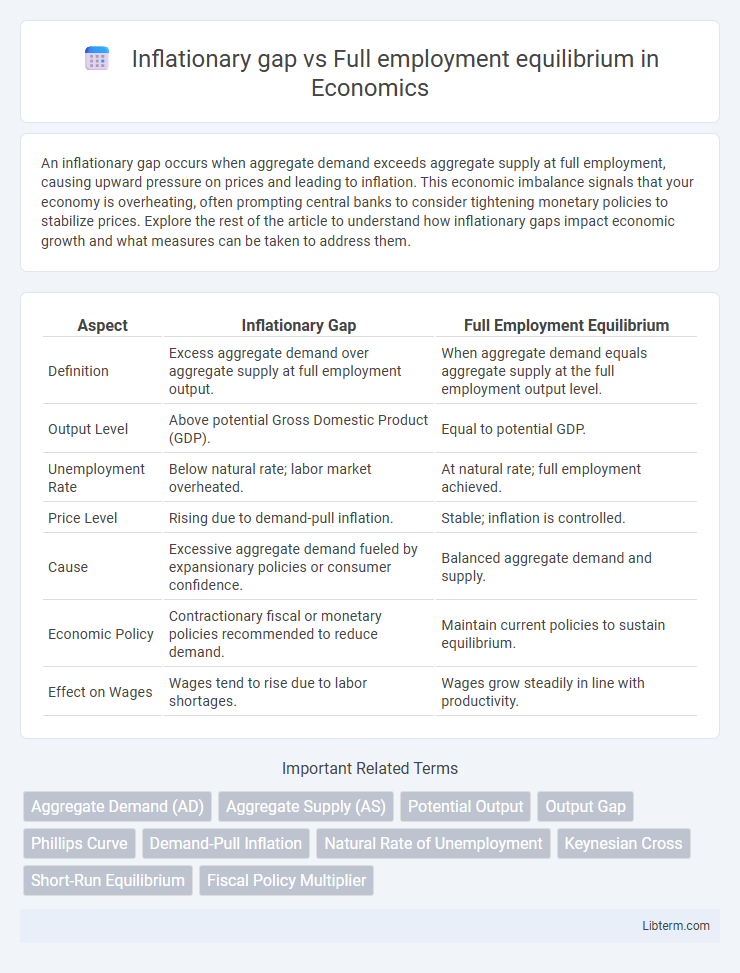An inflationary gap occurs when aggregate demand exceeds aggregate supply at full employment, causing upward pressure on prices and leading to inflation. This economic imbalance signals that your economy is overheating, often prompting central banks to consider tightening monetary policies to stabilize prices. Explore the rest of the article to understand how inflationary gaps impact economic growth and what measures can be taken to address them.
Table of Comparison
| Aspect | Inflationary Gap | Full Employment Equilibrium |
|---|---|---|
| Definition | Excess aggregate demand over aggregate supply at full employment output. | When aggregate demand equals aggregate supply at the full employment output level. |
| Output Level | Above potential Gross Domestic Product (GDP). | Equal to potential GDP. |
| Unemployment Rate | Below natural rate; labor market overheated. | At natural rate; full employment achieved. |
| Price Level | Rising due to demand-pull inflation. | Stable; inflation is controlled. |
| Cause | Excessive aggregate demand fueled by expansionary policies or consumer confidence. | Balanced aggregate demand and supply. |
| Economic Policy | Contractionary fiscal or monetary policies recommended to reduce demand. | Maintain current policies to sustain equilibrium. |
| Effect on Wages | Wages tend to rise due to labor shortages. | Wages grow steadily in line with productivity. |
Understanding the Inflationary Gap
The inflationary gap occurs when aggregate demand exceeds the economy's full employment output, causing upward pressure on prices. During this gap, the economy operates beyond its potential GDP, leading to demand-pull inflation as resources are overutilized. Understanding the inflationary gap is crucial for implementing monetary or fiscal policies that stabilize inflation without hindering economic growth.
Defining Full Employment Equilibrium
Full employment equilibrium occurs when an economy's aggregate demand equals its aggregate supply at the natural level of output, indicating that all available labor resources are being utilized without causing inflation. In this state, unemployment is at its natural rate, and there is no upward or downward pressure on prices, ensuring price stability. The inflationary gap arises when aggregate demand exceeds full employment output, leading to upward pressure on wages and prices due to excessive demand in the economy.
Key Differences: Inflationary Gap vs Full Employment
An inflationary gap occurs when aggregate demand exceeds the economy's full employment output, causing upward pressure on prices and leading to inflation. Full employment equilibrium represents a state where the economy's output aligns with its potential GDP, with no upward or downward pressure on inflation. The key difference lies in the inflationary gap signaling excess demand and rising prices, while full employment equilibrium indicates stable prices and maximum sustainable output.
Causes of an Inflationary Gap
An inflationary gap occurs when aggregate demand exceeds the economy's full employment output, causing upward pressure on prices. Key causes include excessive consumer spending, expansionary fiscal policies, and rapid credit growth that push total demand beyond productive capacity. This disequilibrium triggers rising wages and costs, leading to sustained inflationary pressures in the economy.
Macroeconomic Indicators of Full Employment
The inflationary gap occurs when aggregate demand exceeds the full employment level of output, causing upward pressure on prices and wage rates. Full employment equilibrium is achieved when an economy operates at its natural rate of unemployment, typically around 4-5%, without accelerating inflation. Key macroeconomic indicators of full employment include stable inflation rates, consistent GDP growth matching potential output, and low cyclical unemployment, signaling efficient resource utilization without overheating.
Aggregate Demand and Inflationary Pressures
An inflationary gap occurs when aggregate demand exceeds full employment output, causing upward pressure on prices and accelerating inflation. At full employment equilibrium, aggregate demand aligns with the economy's potential output, stabilizing price levels and minimizing inflationary pressures. Persistent aggregate demand beyond full employment increases wage demands and production costs, further intensifying inflation.
Policy Responses to the Inflationary Gap
Policy responses to the inflationary gap typically involve contractionary fiscal and monetary policies aimed at reducing aggregate demand to match the economy's full employment output. Central banks often increase interest rates to curb borrowing and spending, while governments may reduce public expenditure or increase taxes to decrease overall demand. Such measures help stabilize prices and prevent the economy from overheating, thereby moving it toward full employment equilibrium without accelerating inflation.
Graphical Representation: Gap vs Equilibrium
The inflationary gap appears on the aggregate demand and aggregate supply (AD-AS) graph where the aggregate demand curve intersects aggregate supply to the right of the full employment output level, indicating output beyond the economy's potential; this results in upward pressure on prices due to demand exceeding sustainable supply. The full employment equilibrium occurs at the intersection of the AD and long-run aggregate supply (LRAS) curves, representing an output level consistent with stable inflation and optimal resource utilization. Graphically, the gap between the actual output on the AD-AS graph and the potential output on the LRAS curve quantifies the extent of the inflationary gap.
Economic Consequences of Each Scenario
An inflationary gap occurs when aggregate demand exceeds full employment output, leading to upward pressure on prices and inflation, eroding purchasing power and potentially causing wage-price spirals. Full employment equilibrium represents a balance between aggregate demand and potential output, stabilizing price levels and supporting sustainable economic growth without inflationary pressures. Persistent inflationary gaps can undermine economic stability, while full employment equilibrium fosters optimal resource utilization and long-term productivity gains.
Strategies to Achieve Sustainable Full Employment
To achieve sustainable full employment, policymakers focus on balancing aggregate demand with the economy's productive capacity, avoiding the inflationary gap where demand outpaces supply. Strategies include adjusting fiscal policies to control government spending and taxation, implementing monetary policies to regulate interest rates and money supply, and investing in workforce training to enhance labor market flexibility. These approaches help maintain price stability while promoting job creation, ensuring long-term economic equilibrium without causing inflationary pressures.
Inflationary gap Infographic

 libterm.com
libterm.com